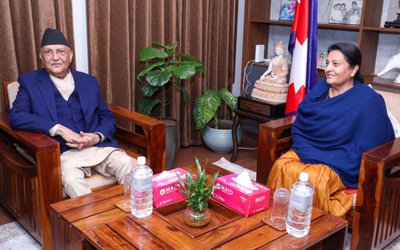More on National






Despite making several efforts, South Asia has the highest number of newborn deaths in the world. Along with highest newborn deaths, the region also has a high proportion (about 5 million) of under-immunized children.
At a time when the region is searching desperately to address the issue, UNICEF recognizes newborn deaths and under-immunization as two of the highest priority health problems in South Asia.
As part of UNICEF’s efforts to generate momentum in saving newborns and children from preventable deaths in the region, UNICEF South Asia launched the South Asia Health Atlas to highlight the importance of tackling newborn deaths and ensuring children are fully immunized in the region.
“In today’s world where policy makers are flooded with information and data, this Atlas aims to help them prioritize and make evidence-based decisions in allocating resources to the neediest in the region,” said UNICEF South Asia.
South Asia Health Atlas provides evidence on the urgency to reach the most disadvantaged children in the region to highlight the importance of two major health problems: tackling newborn deaths and ensuring children are fully immunized in the region. Using the relatively under-used, innovative technique of ring mapping, the Atlas shows deprivations and underlying contributing factors of immunization and newborn deaths across and within countries in the region.
Despite making remarkable progress in decreasing the number of newborn deaths by half from 1990 to 2015, South Asia has the highest number of newborn deaths (more than 1 million in 2015) in the world. Furthermore, 1 in 7 children in South Asia are under-immunized with most living in Pakistan, India and Afghanistan.
“UNICEF strongly believes that no child should die of preventable causes and that all children, no matter where they live or what their circumstances are, have the right to survive and thrive. However, the reality is huge inequities exist in South Asia and not enough women and their newborns benefit from quality care. Also, there are significant disparities in immunization coverage that has contributed to 5 million under-immunized children in the region,” said Jean Gough, UNICEF Regional Director for South Asia.
“The South Asia Health Atlas reveals that challenges relating to newborn health, and also to under-immunization remain in the region. Mapping offers a quick and accessible insight into these problems and possible associations, for example, between adolescent birth rates and newborn deaths; immunization and under five deaths; and how countries with the highest newborn death rates struggle with financing the health system,” said a press release issued by Fungma Fudong, Communication Specialist of UNICEF South Asia.
The Atlas also highlights the usefulness of geospatial mapping for policymaking, especially in today’s world where policy makers are flooded with information and data. This Atlas aims to help them prioritize and make evidence-based decisions in allocating resources to the neediest in the region.
The UNICEF Regional Director for South Asia added, “This Atlas reminds us that unless we accelerate progress on newborn deaths, South Asia will not achieve the Sustainable Development Goal target by 2030. We must ensure that countries in South Asia recommit to saving children and newborns through policies and fiscal plans that address the priority issues, such as immunization and newborn health, with a focus on the poorest.”
South Asia has the highest number of newborn deaths (deaths within the first 28 days of life by UNICEF region) in the world. In 2015, the global number of newborn deaths was 2.7 million. South Asia, alone, had more than 1 million newborn deaths in the same year with India (696,000), Pakistan (245,000) and Bangladesh (74,000) as the highest burden countries.
South Asia has a high proportion of under-immunized children. About 5 million children in South Asia are under-immunized. Most of these children live in Pakistan, India and Afghanistan.
Newborn deaths tend to be among the poorest and most disadvantaged populations in the region. Huge inequities in critical newborn health interventions exist across South Asia.
Almost all births in Sri Lanka (99%) are attended by a skilled attendant (a medically trained provider) compared to only 42 percent in Bangladesh. In India, only 20% of women had a skilled attendant during their last stage of birth in Nagaland compared to almost all women in Kerala (99%), and Tamil Nadu (99%). In Afghanistan, the wealthiest women are about five times as likely to have a skilled attendant at birth as the poorest women.
In Nepal, wealthiest women are twice as likely to receive antenatal care (ANC) than the poorest women. Some countries in the region have made significant improvements in immunization since 1990 – particularly Bangladesh, Sri Lanka and Nepal.
However, immunization coverage is still far too low in high-burden countries: Afghanistan, India and Pakistan. There are also significant disparities in immunization coverage across the region within and between countries. For example, in Afghanistan’s Farah Province, immunization coverage is less than percent whereas in Rajshahi district in Bangladesh, it is 99 percent.
According to UNICEF South Asia Report, not enough women and their newborns benefit from high quality care before and around the time of birth. This includes antenatal care, institutional delivery, a skilled attendant at birth, and postnatal care. Further, not enough newborns benefit from positive behaviors such as initiation of breastfeeding within one hour of delivery. If coverage of these critical interventions increase, many newborns in South Asia can be saved.
Lack of access to health services, a shortage of accurate information for families about immunization, and insufficient investment in health systems all play a part in low immunization coverage.
All children, no matter where they live or what their circumstances are, have the right to survive and thrive. Ending preventable newborn and child deaths is achievable within a generation.
More than two million newborn babies died in South Asia in 1990. By 2015, this number had decreased by half. This shows we can change outcomes for newborns. Modeling work commissioned by UNICEF and partners, and corroborated by two other independent groups, confirms that reducing child mortality in every country to levels associated with high-income countries is feasible by 2030.
Child survival and healthy development remain an urgent concern and we must reach every child to accelerate the progress in ending preventable child deaths.
Progress in efforts to end preventable newborn and child deaths not only means tremendous reductions in human suffering but also substantial economic gains.
For every $1 spent on reducing infectious diseases and maternal and child health, the investment would outweigh the costs by a factor of between 9 and 20 over 20 years from 2015 to 2035.
As long as they aren’t reached with immunization, many children will suffer needlessly of preventable illnesses in South Asia.
Vaccines are one of the most cost-effective health initiatives ever and all children should have access - no matter how hard to reach.
More than half of the under-five deaths worldwide (6.3 million) in 2013 were from infectious diseases, many that could be prevented through vaccination. Countries in South Asia have made commitments to the Sustainable Development Goals (SDGs) for health. Targets include improving vaccination for all and reducing newborn deaths.
Unless we accelerate progress on newborn deaths, South Asia will not achieve the 2030 SDG target of not more than 12 deaths per 1,000 live births.
In Pakistan, newborn deaths have been declining by 1.9 percent each year. This needs to increase to 8.9 percent each year to meet the SDG target.
Similarly, Afghanistan needs to increase its rate of reduction from 1.6 percent to 7.2 percent per year to align with global efforts. India also has a steep challenge to reach the SDG target: moving from 3.2 percent to 5.6 percent reductions each year.
"We know how to save newborns from preventable causes. We have the knowledge and technology. It requires mothers and newborns to receive high quality care around the time of birth – with a particular focus on the most vulnerable and under-served."
It requires a mix of evidence-based and relatively inexpensive but critical health interventions that need buy-in and action from families, communities, healthcare workers and governments.
Some of these effective interventions in saving newborns include breastfeeding, newborn resuscitation, ‘kangaroo mother care’ for premature babies i.e. prolonged skin-to-skin contact with the mother, and preventing and treating infections.
Today, vaccines are protecting more children than ever before.
Vaccines are one of the most successful and cost-effective investments we can make for future generations. Vaccines not only help protect vaccinated individuals, but also help protect entire communities.
As long as they aren’t reached with immunization, about 5 million children will be under-immunised in South Asia, when vaccination could offer an affordable and simple way to protect them.









